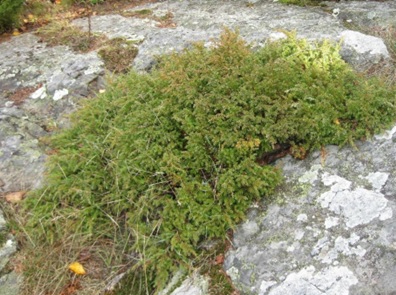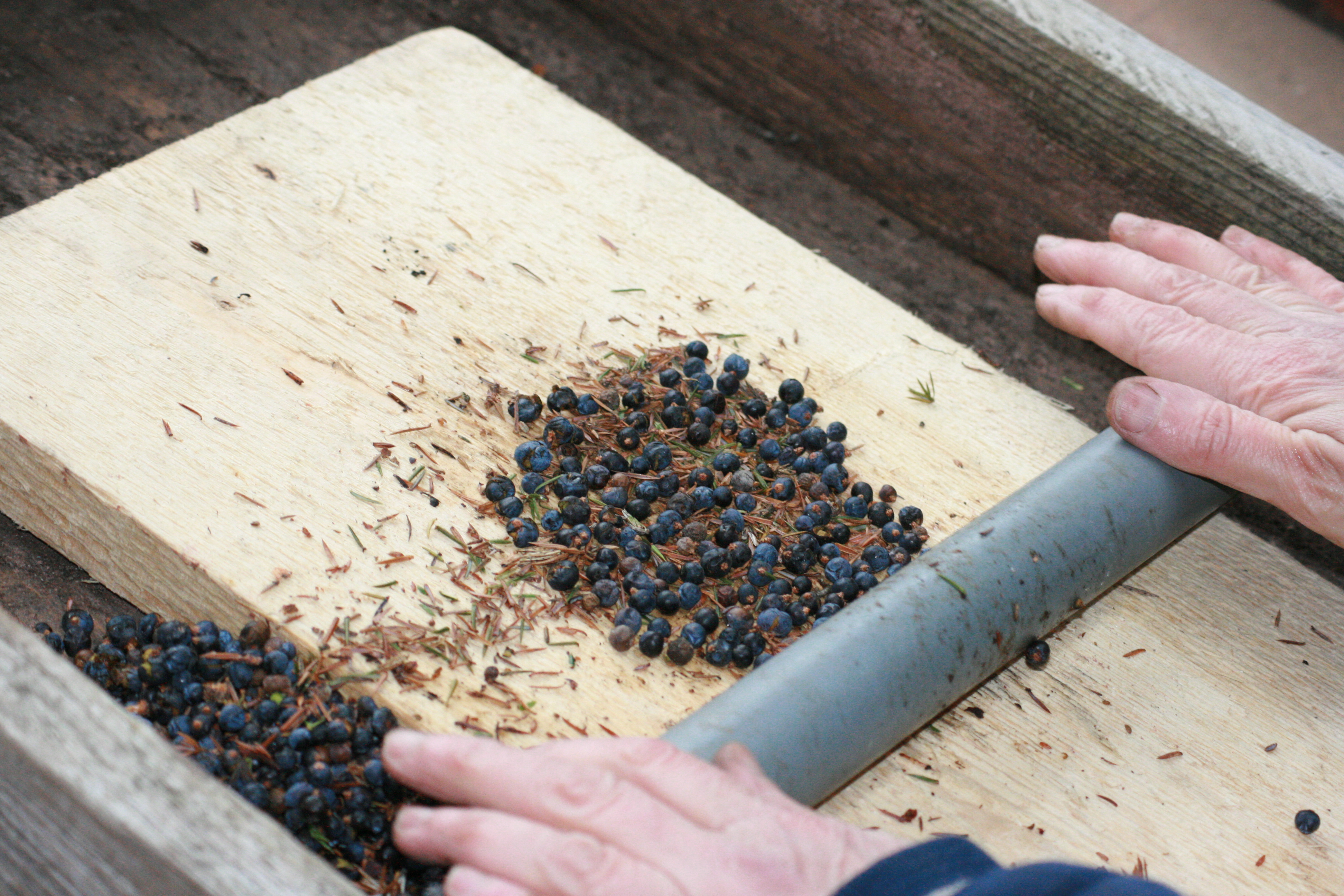By Katherine Schlosser
 Though declared the most widespread of juniper species and appearing widely across the United States, there are eighteen states in which Juniperus communis does not grow as a native: NJ, DE, MD, WV, KY, MO, IA, NE, KS, OK, AR, TN, AL, MS, LA, TX, or HI. Those states may have other juniper species, or cultivated plants, but Juniperus communis is not native to their soil (Flora of North America)
Though declared the most widespread of juniper species and appearing widely across the United States, there are eighteen states in which Juniperus communis does not grow as a native: NJ, DE, MD, WV, KY, MO, IA, NE, KS, OK, AR, TN, AL, MS, LA, TX, or HI. Those states may have other juniper species, or cultivated plants, but Juniperus communis is not native to their soil (Flora of North America)
Robert P. Adams identifies 18 Juniperus species in the continental U.S. with an additional five varieties and three forma (Adams, 2019). The Flora of North America includes 13 species. Globally, the number is higher, primarily in the Northern Hemisphere.
These perennial evergreens grow from one to four feet tall, generally in a shrub-like form sprawling across rocks or soil and occasionally—especially in the northeast—growing upright to as much as 30 feet tall or more. Seed cones mature in one to two years and will last for several months beyond maturity. Each cone bears 1‒13 wingless seeds.
 Well-known to us as the flavoring in gin, juniper species have been known in this country for many years for a multitude of purposes, from culinary, medicinal, and insect control to ceremonial and utility uses.
Well-known to us as the flavoring in gin, juniper species have been known in this country for many years for a multitude of purposes, from culinary, medicinal, and insect control to ceremonial and utility uses.
Several Indigenous Peoples tribal groups tied boughs of juniper to the tops of their homes to discourage lightning strikes (Murphey, 1990). Juniper bark and leaves were considered sacred and used ceremonially (Kavasch, 2005).
Medicinal uses were broad, including for treatment of high blood pressure, as a diuretic, and to improve the appetites of the elderly (Garrett, 2003). A salve was made of the oil from the cone, mixed with fat, to protect wounds from flies. Smoke from the burning wood or leaves was inhaled to treat colds and to repel insects. Tea was given to induce a speedy delivery, and in 14th-century Europe, in the midst of Black Death (bubonic plague), juniper tea was used to sterilize bandages (Harrington, 1967).
We have learned from history; and studies on the properties and efficacy of juniper essential oils continue, looking particularly at the antiseptic and antibiotic possibilities. The Food & Drug Administration has approved an oral medication to treat fungal infections (Cabello et al., 2010).
 There are many recipes for using juniper berries, which can now be found in the spice section of many grocery stores. While some may find the taste a bit strong or resinous, others find it adds wonderful flavor to meat dishes, vegetables, and even baked goods.
There are many recipes for using juniper berries, which can now be found in the spice section of many grocery stores. While some may find the taste a bit strong or resinous, others find it adds wonderful flavor to meat dishes, vegetables, and even baked goods.
The scent of gin is prominent in crushed berries, which blend well with cheese and fruit. The berries (actually cones) can be eaten raw, but are most often dried. Even then, it is suggested that not too many be eaten at one time. Just a few will flavor enough meat or game for four people.
The essential oil of juniper is composed primarily of monoterpene hydrocarbons such as α-pinene, myrcene, sabinene, limonene, and β-pinene, lending some familiar lemony, spicy, and piney scents.
 We learned from Indigenous Peoples to dry, then powder, the fruits, using the powder much as we do black pepper. Others teach burning the leaves, pouring boiling water over the ashes, straining the liquid, and using it as a flavoring.
We learned from Indigenous Peoples to dry, then powder, the fruits, using the powder much as we do black pepper. Others teach burning the leaves, pouring boiling water over the ashes, straining the liquid, and using it as a flavoring.
The wood of juniper trees is strong and has been used, in spite of its often small size, for long-lasting craft items for household and kitchen use.
There was a time, prior to my HSA membership, when I dismissed Juniperus communis for landscape use, seeing it most often used commercially where it seemed to attract trash. I know better now that, in well-kept landscapes, it is lovely, its history is interesting, and its culinary uses delightful. I no longer have need for contraceptives or speedy deliveries, but a bit of gin once in a while might be good for aching knees after a day in the garden.
Medicinal Disclaimer: It is the policy of The Herb Society of America, Inc. not to advise or recommend herbs for medicinal or health use. The information in this presentation is intended for educational purposes only and should not be considered as a recommendation or an endorsement of any particular medical or health treatment. Please consult a health care provider before pursuing any herbal treatments.
Photo Credits: 1) Juniperus communis, Londonderry, New Hampshire (K. Schlosser); 2) Gin and tonic (cyclonebill, Openverse); 3) Juniperus communis cones (MFP, Wikimedia Commons); 4) Crushing juniper berries (far closer, Openverse).
References
Adams, Robert P. 2019. Juniperus of Canada and the United States: Taxonomy, Key and Distribution. Lundellia 21(1), 1-34. https://doi.org/10.25224/1097-993X-21.1
Cabello, Peláez F., et al. 2010. The discovery of enfumafungin, a novel antifungal compound produced by an endophytic Hormonema species biological activity and taxonomy of the producing organisms. Syst Appl Microbiol. 23 (3): 333–343. doi:10.1016/s0723-2020(00)80062-4
Flora of North America, Juniperus communis Linnaeus, Sp.Pl. 2: 1040. 1753 FNA, Family List, FNA Vol. 2, Cupressaceae, Juniperus. http://www.efloras.org/florataxon.aspx?flora_id=1&taxon_id=200005424
Garrett, J. T. 2003. The Cherokee Herbal: Native Plant Medicine from the Four Directions. P. 79. Bear & Company, Rochester, VT.
Harrington, H.D. 1967. Edible Plants of the Rocky Mountains. P. 242. University of New Mexico Press.
Kavasch, E. Barrie. 2005. American Indian Wild Foods and Recipes. Dover Publications. Reprint of Native Harvests: Recipes and Botanicals of the American Indian, Random House, 1975.
Murphey, Edith Van Allen. 1990. Indian Uses of Native Plants. Meyerbooks, IL. Reprint of 1958 publication by Mendocino County Historical Society. Pg. 50.
In her 32 years of HSA membership, Kathy has served in positions at the local, district, and national levels. While on the National Herb Garden Committee, she spearheaded the NHG fundraising project with the publication of The Herb Society of America’s Essential Guide to Growing and Cooking with Herbs (LSU Press, 2007). As the initiator of the Native Herb Conservation Committee, she oversaw the establishment of GreenBridges , the Notable Native Herb
, the Notable Native Herb project, and the HSA Fuzzy Butts Bee Observation Day. She has been awarded the Gertrude B. Foster Award for excellence in herbal literature and the Helen De Conway Little Medal of Honor. She has been involved in plant conservation in North Carolina for 35 years and has written for local and national publications. She is currently working on a second book.
project, and the HSA Fuzzy Butts Bee Observation Day. She has been awarded the Gertrude B. Foster Award for excellence in herbal literature and the Helen De Conway Little Medal of Honor. She has been involved in plant conservation in North Carolina for 35 years and has written for local and national publications. She is currently working on a second book.
Leave a Reply